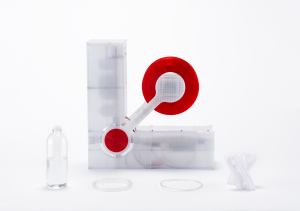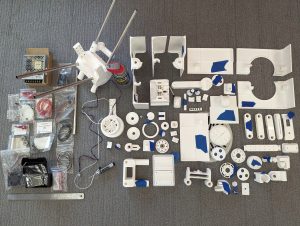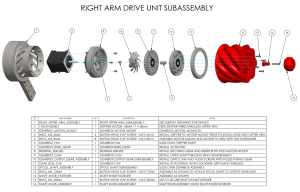Introduction
The massive amount of plastic bottles incinerated or dumped in landfills or oceans is a growing global concern. In the United States alone, despite recycling efforts, 22 billion plastic bottles are incorrectly disposed of each year. It is evident that our current recycling strategy has been falling short for the past 60 years, and it gives us false confidence to continue our plastic-dependent lifestyle. In response to this urgent problem, Williams College, through a collaboration between the Makerspace and Zilkha Center for Environmental Initiatives, has embarked on an innovative sustainable 3D-printing project that seeks to upcycle plastic bottles into 3D print filament.
Recycling Methods: Ineffectual at Best and Deceptive at Worst
The current state of plastic waste recycling presents significant challenges and limitations. Recent statistics highlight the large scale of this issue as well as the urgent need to seek innovative and improved solutions. The United States, for example, generated approximately 40 million tons of plastic waste in 2021, of which only 5-6% (two million tons) were recycled, far below previous estimates. Moreover, between 2019 and 2020, there was a 5.7% global decrease in plastics recovered for recycling, resulting in a net decrease of 290 million pounds. These statistics indicate a concerning downward trend in plastic recycling efforts.
The annual global production of approximately 400 million tons of plastic waste adds to the growing environmental crisis. Import bans by countries like China and Turkey have hindered recycling efforts, as the United States previously relied on outsourcing a significant portion of its plastic waste for recycling. The inherent challenges of plastic recycling, such as its degradation in quality with repeated recycling, make it less suitable for circular recycling processes. In the United States, the total bottle recycling rate has declined, with 2.5 million plastic bottles discarded every hour. Similarly, the global accumulation of plastic waste in oceans, estimated to be between 75 and 199 million tons, poses a severe threat to marine life and ecosystems, and the long degradation time of plastic bottles, which can take over 450 years, adds to the concern.
These statistics emphasize the pressing need to address the limitations of Polyethylene terephthalate (PET) plastic recycling. Relying solely on conventional recycling methods is inadequate to tackle the magnitude of the problem. Innovative approaches, such as upcycling, are crucial for effectively reducing plastic waste and minimizing our environmental impact. By finding alternative uses for plastic materials, we can break free from the limitations of circular recycling processes and make a significant change in helping eradicate the plastic waste crisis.
Myths, Pros, and Cons of Recycling and Upcycling
Recycling: Despite its benefits, the reality is that after being collected and aggregated, much of the recycled content is stored in unsafe locations until it overflows and is eventually landfilled or burned. Recent incidents, such as a recycling center fire in Richmond, Indiana, highlight the dangers, inefficiencies, and serious consequences of the current recycling system.
In addition, when plastics are recycled, their potential recyclability is subsequently decreased. PET is classified as grade 1 plastic due to its high recycling potential. However, once it is recycled, it downgrades to the 7th grade, which is no longer recyclable. For this reason, at the Williams Makerspace, we decided to implement the strategy of upcycling that aims to repurpose PET plastic instead of recycling it to provide longer durability.
Upcycling: Upcycling offers an alternative approach by diverting items from the waste stream and enabling their reuse. While upcycling may not restore plastic to its original grade, it provides a longer second life for the material before it becomes waste once again. Upcycling is the practice of transforming a disposable object into one of greater value. Therefore, upcycling contrasts the idea that an object has no value once disposed of or must be destroyed before reentering a new circle of production and value creation.
The Polyformer Prototype and Its Value
The Polyformer is a sustainable 3D printing project that aims to convert PET plastic bottles into 3D printer filament. For the purposes of this project, the filament will initially be used to produce 3D-printed plant pots and compost bins for the Zilkha Center, effectively converting waste into items that can be utilized on a day-to-day basis. This process could reduce the purchase of virgin plastic objects (i.e., pots and bins), reducing carbon-related shipping emissions and reducing waste generated by single-use plastics. This project aims to explore the environmental impact of repurposing on-site waste into products needed on campus. Additionally, this project offers a prototype for developing locally-sourced 3D printer filament, which would reduce our dependence on purchasing virgin filament that is typically sourced from other countries, such as China, and bears a carbon footprint. The project’s goals include providing an educational opportunity for the students to engage in environmental activism by repurposing single-use plastic bottles into 3D filament and useful objects for the Williams College community.
The Polyformer is an open-source project with over 4,000 Discord members. It is a prototype and has pain points, such as that the bottles require manual cleaning, individual manual placement onto the machine, and any impurities that can cause the filament to fail (break or clog) in the 3D printer. The Polyformer community is actively addressing these issues, and while solutions do not yet exist, this is an exciting project that offers an opportunity to disrupt the stream of plastic waste.
Project Goals and Alignment with Williams’ Strategic Objectives
The project’s goals align with the Williams College Zero Waste Action Plan, which builds upon the sustainability strategy in the college’s strategic plan, focusing on three of its goals. Firstly, it offers an educational opportunity for students to engage in environmental activism and learn about upcycling as a solution to plastic waste. Secondly, the project promotes sustainability by reducing waste and carbon emissions associated with single-use plastics. Thirdly, it reinforces Williams College’s commitment to local engagement and community impact by providing practical and sustainable solutions to address environmental challenges.
Building the Polyformer
The Polyformer is a tool that will allow Makerspace student workers to manually automate cutting a water bottle into a long, consistent ribbon that feeds into a repurposed 3D printer hot end, converting it into a standard 1.75 mm filament. Building a Polyformer requires 3D printing 78 individual parts and then assembling those with a Bill of Materials (BOM) that can be sourced individually or purchased as a kit. This acquired kit includes a circuit board, LCD screen, a volcano heater block and 0.4 mm hot end, a stepper motor, stainless steel tubing, bearings, neodymium magnets, lots of wires, and a box of metal fasteners.
We have printed all 78 parts, and my fellow Makerspace student workers have been instrumental in helping to complete that process. The next stage, which I plan to begin this summer, is assembling and testing the Polyformer to transform the plastic bottles into 3D-printer filament.
Polyformer as a Disruptor
This project aims to disrupt our plastic-centric world in several ways. By repurposing plastic bottles into valuable filament, it challenges the notion that disposables have no value once discarded. Furthermore, it reduces dependence on external filament sources and contributes to a more self-sufficient and sustainable production cycle.
Polyformer: Next Steps
The project is currently in the prototyping phase, and this summer, I hope to begin assembling the Polyformer and, subsequently, testing it under a science lab hood. We will use a hood to vent the area because the process of melting PET/G ribbon, from the bottles, into filament releases antimony – a suspected carcinogen — and other volatile organic compounds (VOCs). When our Polyformer works as expected, students will
then volunteer to collect approximately 200 plastic bottles (a standard 1 kg roll of filament requires approximately 40 bottles) to manufacture sufficient filament to produce the four large plant pots and 22 compost bins. The pots and bins will be provided to Zilkha Center gardening interns and the Sustainable Living Community at the College, serving as practical examples of upcycling in action.
Conclusion
The sustainable 3D printing project at Williams College represents a powerful initiative to combat plastic waste through upcycling. By repurposing plastic bottles into valuable filament and creating sustainable products, the project aligns with Williams’ commitment to environmental stewardship and community engagement. Through innovative approaches like this, we can work towards a future with reduced plastic waste, increased sustainability, and a more conscious approach to consumption.
References
- USA Plastic Bottles Pollution: https://www.container-recycling.org/assets/pdfs/media/2006-5-WMW-DownDrain.pdf
- Plastic Pollution as a Global Issue: https://www.sciencedirect.com/science/article/pii/S0304389421018537 https://education.nationalgeographic.org/resource/one-bottle-time/
- The evolution and current situation of Plastic Pollution: https://www.sciencedirect.com/science/article/abs/pii/S0025326X22001114
- What is Upcycling?: https://www.researchgate.net/publication/303466628_Upcycling
- What is the Polyformer?: https://www.reiten.design/polyformer https://www.aliexpress.us/item/3256804888534268.html
- Recycling data: https://blog.nationalgeographic.org/2018/04/04/7-things-you-didnt-know-about-plastic-and-recycling/.
- Plastics Material Specific Data: https://www.epa.gov/facts-and-figures-about-materials-waste-and-recycling/plastics-material-specific-data
- Richmond, Indiana Recycling Plant Fire: https://www.nytimes.com/2023/04/12/us/richmond-indiana-recycling-plant-fire.html
- Williams College Strategic Plan and Zero Waste Action Plan: https://sustainability.williams.edu/waste/zero-waste-action-plan/ https://president.williams.edu/strategic-plan-2021/



